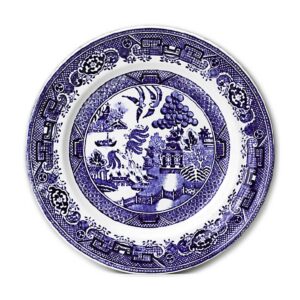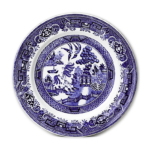
Willow Pattern, also known as “Hiei Pattern” in the United Kingdom. It is also called Hibi Pattern. There are minor differences in design, but the pattern consists of a waterside hall and an island, with a willow tree in the center and a bird with wings above it. The design is based on a Chinese legend of a tragic love story. In other words, when the daughter of a great official and a young man who was his guest became intimate, the official broke their relationship and locked the daughter up in a room. The daughter was anguished by the willow flowers outside the window. The Grand Councilor took the young man to the bridge connecting the daughter’s confinement room and the main residence and chastised him with a whip, but he could not break their hearts, so he finally had the daughter sent away to a small island. The young man, however, took a boat out at night, and the two were very affectionate. When the chief magistrate learned of this, he was so furious that he set fire to the island, but strangely enough, a pair of birds flew out of the burning fire and flew away peacefully. Around the 17th or 8th century, a Dutchman traveling in China became interested in this legend and attempted to create a design symbolizing this story with a hall, bridge, island, boat, willow, and birds, and first applied it to an indigo-painted copper plate in the Netherlands. This design was apparently very popular with Europeans, and there are many examples of this type of pottery in England, as well as in France. In addition, this design was applied to products for export in China, and is now being manufactured for export in Japan as well.








